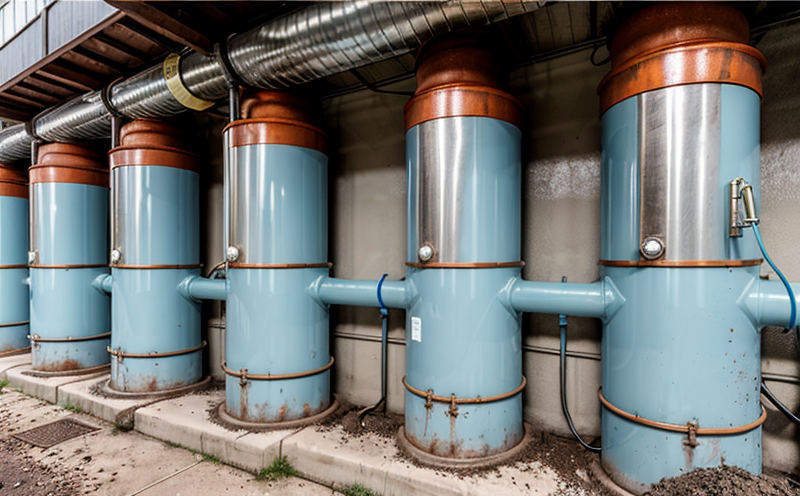ASTM G220 Scale Composition Analysis Test in Water
The ASTM G220 scale composition analysis test is a critical tool used to analyze the chemical and mineral composition of scales formed within water systems. This test plays an essential role in understanding the types of materials that contribute to scaling, which can lead to significant operational challenges for water and wastewater facilities.
Scaling, the formation of insoluble deposits on surfaces such as pipes, boilers, or heat exchangers, is a common issue affecting various industrial sectors. The composition of these scales can vary widely depending on the source of water, treatment processes, and operating conditions. By conducting ASTM G220 tests, operators can identify specific minerals like calcium carbonate, magnesium hydroxide, or iron oxides that contribute to scaling. This knowledge is vital for selecting appropriate countermeasures such as corrosion inhibitors, pH adjustment chemicals, or alternative water sources.
The test process involves the collection and analysis of scale samples taken from equipment suspected of being affected by scaling issues. Samples are prepared according to ASTM G220 guidelines, ensuring consistent results across different facilities. Once collected, these samples undergo detailed chemical analysis using techniques like X-ray fluorescence (XRF) spectroscopy or inductively coupled plasma optical emission spectrometry (ICP-OES).
Understanding the composition of scales is not only beneficial for maintenance planning but also helps in assessing the effectiveness of scale inhibition strategies. For instance, if calcium carbonate is identified as a major component of scaling, operators may opt for treatments that target this mineral specifically. Additionally, insights gained from ASTM G220 tests can inform decisions regarding water source selection or treatment process optimization.
Water and wastewater facilities are particularly susceptible to scaling issues due to the wide range of minerals present in raw water sources. Proper application of ASTM G220 test results ensures that appropriate measures are taken to mitigate these problems, thereby enhancing operational efficiency and extending equipment lifespan. By leveraging this information, facility managers can make informed decisions about maintenance schedules, chemical dosages, and even infrastructure upgrades.
Why It Matters
The importance of ASTM G220 scale composition analysis cannot be overstated in the context of water and wastewater testing. The presence of scales can cause significant operational challenges within these systems. For instance, scaled pipes may suffer from reduced flow rates or even complete blockages if not addressed promptly.
- Reduction in heat transfer efficiency leading to increased energy costs
- Potential for equipment failure due to excessive buildup on critical components like valves and pumps
- Increased maintenance frequency and associated downtime
- Decreased water quality as contaminants bypass filtration systems
The identification of scale composition through ASTM G220 allows operators to implement targeted strategies aimed at preventing or reducing scaling. This proactive approach helps maintain optimal system performance, ensuring reliable service while minimizing disruptions.
In addition to operational efficiency, understanding scale composition also aids in long-term planning for facility upgrades and expansions. With accurate data from ASTM G220 tests, managers can assess the need for new equipment or modifications to current setups based on expected usage patterns and environmental factors.
Scope and Methodology
| Step | Action | Description |
|---|---|---|
| 1 | Sample Collection | Collect scale samples from equipment suspected of being affected by scaling issues. |
| 2 | Preparation | Prepare the collected samples according to ASTM G220 guidelines ensuring consistency across tests. |
| 3 | Analysis | Analyze the prepared samples using techniques such as X-ray fluorescence (XRF) spectroscopy or ICP-OES for detailed composition analysis. |
| 4 | Data Interpretation | Interpret the analytical results to identify specific minerals contributing to scaling within the system. |
| Step | Action | Description |
|---|---|---|
| 5 | Reporting | Create detailed reports summarizing findings, including recommendations for mitigation strategies. |
| 6 | Follow-Up | Monitor the effectiveness of implemented measures over time and adjust practices accordingly based on ongoing ASTM G220 test results. |
| 7 | Evaluation | Periodically evaluate overall system performance and compare it against initial conditions to ensure sustained improvement. |
The ASTM G220 scale composition analysis follows a structured approach that ensures accuracy and reliability in identifying the minerals responsible for scaling. This methodical process allows operators to take informed actions tailored specifically to their unique circumstances, ultimately leading to more effective management of water systems.
Environmental and Sustainability Contributions
Reduction in resource consumption: By minimizing scaling through targeted interventions based on ASTM G220 test results, facilities can reduce the amount of water lost due to blockages or reduced flow rates. This conservation effort contributes positively towards overall water stewardship efforts.
Decreased energy usage: Removing scales from heat exchangers and other components enhances their efficiency, resulting in lower heating costs for industrial processes that rely heavily on thermal transfer.
The implementation of ASTM G220 scale composition analysis tests supports broader sustainability goals by promoting efficient use of resources and reducing environmental impact associated with scaling incidents. These benefits extend beyond individual facilities to contribute positively towards sustainable development objectives at larger scales.





